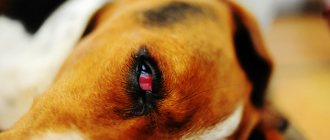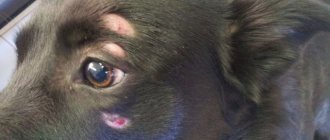When taking a dog into your home, you need to be prepared for a lot of hassle, both pleasant and not so pleasant. Like people, animals are susceptible to many diseases, but unlike a person who can clearly describe how they are feeling, a dog will suffer in silence.
Pododermatitis is a fairly common disease characterized by an inflammatory process in the interdigital space and on the pads of a dog’s paws. Severe pain that occurs when moving forces the animal to move less. An attentive and responsible owner will easily identify changes in his dog's behavior and immediately take him to the veterinarian.
Causes of the disease
Pododermatitis in dogs is always a secondary disease that develops against the background of some underlying disease. Veterinary experts believe that pododermatitis occurs in animals with weak immunity. Before starting treatment for dermatitis, it is important to first find out the true cause of its development, otherwise the therapy will be ineffective.
The main causes of pododermatitis are:
- fungal skin infections;
- disturbances in the hormonal system, endocrine diseases;
- the presence of parasites in the animal’s body (fleas, ticks, helminths);
- allergic dermatitis (contact or food);
- cancerous tumors;
- bacterial infections caused by staphylococcus, Proteus, Pseudomonas aeruginosa, etc.;
- autoimmune diseases (vasculitis, systemic lupus erythematosus);
- various injuries and cracks on the pads of the paws and fingers;
- getting glass, sharp objects and thorns under the skin of the paws;
- irritating factor (asphalt pavement, reagents added when ice occurs in winter).
Some dog breeds (Labradors, German Shepherds, Dachshunds and Pekingese) are particularly susceptible to pododermatitis. It is in these breeds that the disease is diagnosed more often than in other animals.
Prevention and precautions
In order to avoid such a problem, pet owners are advised to follow the following rules:
- Watch your dog's diet; nutrition should be complete.
- If your four-legged friend lives in a kennel or enclosure, keep it clean.
- Trim the hair between the toes so that there is no accumulation of microorganisms there, cut off the nails.
- Take your dog to the doctor for regular checkups.
- Disinfect your pet's paws after every walk.
- If your animal is accustomed to wearing shoes, do not break this tradition; it is most likely not ready for barefoot walks.
- It is better to wash your paws after a walk to avoid problems.
- To be safe, you can lubricate the paw pads with wax; it will prevent bacteria from entering the body.
We are responsible for those we have tamed, which means we must take care that our pets live well near us. But dogs don’t need much: to be healthy and our attention. We can give it to them.
Symptoms of pododermatitis in dogs
Depending on the cause that provoked pododermatitis, the symptoms of the disease will vary significantly, but there are also general signs of the disease that are characteristic of all forms of pododermatitis:
- The dog's limbs swell and become swollen.
- The animal begins to limp, and if the disease is particularly severe, the dog may completely lose motor function.
- The pet constantly licks its paws and looks restless.
- In the space between the toes and on the pads of the paws, the skin, as a rule, becomes very red, inflamed, and the animal feels sore. The formation of fistulas, wounds, and abscesses often occurs.
The development of pododermatitis due to fungus or bacterial microflora is accompanied by redness, inflammation and swelling of the areas between the toes and paw pads. Often ulcers and ulcers form on the affected areas. Local body temperature rises.
Allergies that appear after contact with various reagents cause symptoms of pododermatitis such as:
- redness and inflammation of the skin;
- very severe itching on the paws, fingers can hardly be distinguished due to scratching (the skin is so torn);
- baldness of the paws (hair rapidly thins and falls out).
General allergies have similar symptoms to contact allergies, but the affected areas are concentrated not only on the dog’s limbs, but also on other parts of the animal’s body (the muzzle most often suffers).
Pododermatitis, which appears against the background of autoimmune diseases, is more difficult to diagnose than all other forms of the disease. To identify this type of dermatitis, you will need to undergo many tests. The symptoms are similar to allergic pododermatitis, but there are still some differences: the skin of the paw pads becomes very thick and darkens.
The endocrine factor of pododermatitis is manifested by severe redness and inflammation of the skin in the interdigital space.
Pododermatitis of an oncological nature is considered the most dangerous and is characterized by the appearance of various neoplasms, growths and ulcers on the pet’s body.
Find out also about other skin diseases in dogs >>>
How do symptoms appear?
Pododermatitis is characterized by the following features of inflammation on the paws:
- wounds on the fingertips or between them;
- red or pink vesicles filled with blood;
- skin redness;
- swelling of the fingers or joint;
- the inflamed area may itch in some cases, but not in others.
The pet is limping and tries to protect its paw when walking. The disease can affect not only the skin, but also the claws, interdigital folds, the surface of the metacarpus and metatarsals. They swell, and in the later stages of the disease they fester.
Did you know? In the USA there is the only church in the world for dogs. It was built in the 19th century in Vermont by artist Stefan Hanek as a thank you to his pets who helped him recover from a serious illness.
Exactly how the paw swells is a secondary sign that influences the diagnosis. So, any paw can be injured by a foreign object. But an allergic reaction is more common in the front ones than in the back ones.
Diagnostics
If signs of pododermatitis appear, the animal should be taken to a veterinarian as soon as possible. The doctor will definitely ask the dog owner about such features as:
- seasonality of the disease;
- contact of the four-legged pet with other relatives;
- introducing new products into the animal’s diet;
- the owner's attempts to cure the disease on his own.
To make an accurate diagnosis, the following methods are used:
- general and biochemical blood test;
- Analysis of urine;
- allergen tests;
- cytology;
- biopsy;
- antimicrobial susceptibility test.
Differential diagnosis excludes the presence of diseases such as fungal skin infection and demodicosis.
Treatment of various forms of interdigital dermatitis
Treatment for interdigital dermatitis in a dog will depend on what exactly is identified as the underlying cause:
- Infectious and bacterial diseases are treated using a course of antibiotics.
- Parasitic infections - treating your pet for external parasites.
- Treatment of dermatitis of allergic origin begins with the elimination of allergens from the dog’s environment.
- If claw dystrophy or ulcers on the fingers are diagnosed, then drug therapy is used, for example, high doses of essential fatty acids and glucocorticoids.
- If a fungal infection is detected, antifungal therapy is given over a long period of time due to the slow growth of the nails. The average animal requires at least 6 months of drug treatment.
If the therapy does not show the desired result, the doctor may suggest removal of the affected nails as the only effective option.
Traumatic
A dog can injure its paw at any time during a walk. The forelimbs are affected more often than the hind limbs. In this case, foreign objects and dirt often get into the wound. It becomes inflamed and subsequently accompanied by suppuration.
First aid for injury:
- Rinse your paw.
- Treat with antiseptic “Chlorhexidine”, “Miramistin”, “Percutan” or “Hydrogen Peroxide”.
- Lubricate the damaged area with Tetracycline or Ichthyol antibacterial ointment.
- Apply a bandage.
Find out what to do if your dog's hind legs fail: causes and treatment.
If the injury is not eliminated in a timely manner, the inflammation causes itching, which leads to intense licking of the itchy area and increases irritation.
Some injuries are caused by physiology:
- Flat feet in Pekingese and Terriers predispose them to folliculitis and the development of dermatitis.
- Labradors have wide paws with a large distance between the toes, which also predispose them to dermatitis and disease due to the fact that the dog's weight is distributed not only on the foot, but also on the space between the toes.
Allergic
The substances that can cause allergic reactions in dogs are many of the same ones that cause the same reactions in humans, including grass, tree and flower pollen, dust mites and mold. If the disease worsens in a certain season, then most likely we are talking about pollen or chemical reagents for sprinkling the road in winter. If there is no such connection, then the likely cause of the disease is food or a reaction to flea saliva.
Important! Flea allergies affect dogs that usually do not have fleas. Because of this, one bite can cause a problem for 5 years.
-
7 days. Allergy treatment consists of several procedures:
- Therapeutic baths (weekly or once every 2 weeks). Water washes away allergens that have accumulated on the fur, and can also have a soothing effect if you add antimicrobial and antifungal agents to it.
- Use of antihistamines. They do not cure, but relieve the symptoms of inflammation. The following drugs are often used: Benadryl, Chlortrimeton, Atarax, Claritin, Zyrtec and Clemastine.
- To treat secondary infections that may accompany allergies, antibiotics “Penicillin” and “Levomycetin” are used.
- To combat fleas and allergies to them, anti-flea shampoos “Miconazole”, “Clotrimazole”, “Triclosan” are used.
- Omega-3 and Omega-6 essential fatty acid supplements improve overall skin health. They are also natural anti-inflammatory and antioxidant substances.
- Corticosteroids, drugs such as Prednisolone and Dexamethasone, reduce itching and inflammation. But they should be used only as prescribed by a doctor, because... These medications have side effects such as thirst, appetite, increased urination, and behavioral changes.
Staphylococcal
Staphylococcal dermatitis is caused by Staphylococcus bacteria. They are usually found on the dog's skin and do not cause problems. But as soon as the immune system weakens, the skin becomes irritated and inflamed, they penetrate into the upper layers of the epidermis and begin to actively develop. All this is accompanied by itching and scratching of the skin, ulcers.
Treatment consists of:
- Oral antibiotics. Prescribed "Enroxil", "Ciflox", "Baytril".
- To improve immunity, immunomodulators are prescribed: Ribotan, Fosprenil, Glycopin, Immunofan, Maksidin.
Symptomatic therapy is also used: antiseptics and other means to reduce the number of staphylococcal bacteria on the skin and the consequences of their activity.
Important! You should not give your dog immunomodulators “just in case.” This may cause allergies to medications.
Bacterial infections in dogs are usually secondary to injury. They manifest themselves in the form of tissue swelling, inflammation, redness of the skin and may be accompanied by pain. They are treated with a course of antibiotics.
Parasitic
Peloderae pododermatitis is caused by nematodes of the same name. The larvae penetrate the skin and can be found on scrapings. Infection ends once the source of contamination is removed. For treatment, the dog is washed with anti-parasitic shampoo and all its sleeping accessories that may contain nematodes are replaced.
Infection with hookworms (Ancylostoma and Uncinaria) occurs due to poor sanitary conditions in which the animal lives. The larvae penetrate the skin and cause itching. The paw pads become porous and soft, especially around the edges. Chronic inflammation causes rapid growth of nails, which are easily deformed and broken. Hookworm infection is diagnosed based on stool analysis and clinical signs of parasitic infection.
Interdigital dermatitis also occurs due to Demodex mites. Pathology is diagnosed by skin scrapings and biopsy. It often occurs in dogs over 4 years of age and is one of the most commonly misdiagnosed skin conditions.
Treatment should be aimed at eliminating parasites:
- Use oral antiparasitic drugs, injected or in the form of an ointment on the infected area of skin. For example, “Ivermectin” 1% at a dosage of 0.1 ml per 5 kg of animal weight once, intramuscularly.
- The wound surface is treated with an antiseptic and anti-inflammatory ointment is applied every 8 hours.
Psychogenic
Canine psychodermatopathy is under study. The problem arises when the animal becomes stressed. The nervous reaction causes itching, so the animal begins to bite and scratch the fur in different areas. For treatment, sedatives are prescribed that can reduce stress levels. These are “Sanal”, “Antistress Bifar”, “NoviPet”.
Did you know? The belief that a warm, dry nose is evidence that a dog is sick originated in medieval Europe during the plague. A dog infected with distemper did have these symptoms, but there are many diseases that will cause the nose to remain cool and moist.
Is it possible to treat dermatitis with iodine?
There is no general treatment for interdigital dermatitis due to the fact that it is a manifestation of different diseases. But there are many products that can be suitable for disinfecting and drying the skin area. Iodine works well to treat staph infections.
It is an antiseptic and will always be effective in treating:
- dermatitis, as well as any other redness of the skin;
- eczema, incl. accompanied by itching;
- fungal infections of the interdigital space;
- various wounds on the skin, cuts and inflammations.
The technique for using iodine will be as follows:
- Soak a cotton swab or cotton swab in iodine.
- Apply to the affected area of skin. Press the swab firmly so that the iodine penetrates into the upper layers of the epidermis.
- Repeat 2-3 times a day until the skin damage disappears completely.
- Soaking the affected nail in iodine can also be effective against fungal infections.
The more carefully you follow the application schedule, the faster you can get rid of the disease. But remember that iodine eliminates the external manifestation of the disease, but does not cure it. Therefore, if you have a strange skin condition on your dog’s paws, be sure to visit a veterinarian, establish the exact cause of the disease and get a prescription.
Treatment of pododermatitis in dogs
Treatment methods directly depend on the cause of the disease. There are no general treatment tactics; treatment is selected individually for each sick animal. The following methods are mainly prescribed:
- use of antimicrobial drugs;
- use of antifungal agents;
- antihistamine therapy;
- treating affected skin with antiseptics;
- lifelong use of certain medications;
- special diet;
- surgical intervention.
The veterinarian prescribes treatment depending on the type of pododermatitis identified in the sick dog:
- The aseptic appearance is characterized by persistent inflammation and severe pain. Tissue damage is usually not accompanied by a purulent process. Treatment at home is aimed at daily treatment of wounds with antiseptic agents.
- The purulent form of pododermatitis occurs with the addition of a purulent infection. The symptoms of purulent dermatitis are so vivid (severe pain, high temperature) that there is no doubt about the diagnosis. This form of the disease should be treated only with antimicrobial drugs. In particularly severe cases, surgery is prescribed to remove the affected tissue.
Treatment of pododermatitis is very long, but even after a positive outcome of therapy, relapses of the disease are often observed (especially in winter and autumn).
Diagnosis and therapy
Diagnosis is based on medical history and clinical signs. Additional tests, including bacterial culture and antibiotic sensitivity testing, biopsy, urine and blood tests, and allergy tests, are performed depending on your pet's medical history.
Thus, pododermatitis in dogs should be treated based on its root causes. Antibiotics, antifungal drugs, acaricidal drugs, etc. are used. Treatment with antibiotics begins only after identifying the pathogen and conducting a sensitivity test to the drug.
Ingrown claws
This disease usually affects small indoor dogs that are constantly in the apartment. They don't have enough space to run, and they don't go for walks. The claws do not sharpen, like other dogs, and grow a lot. Long nails bend and stick into the pads of the paws. Purulent inflammation begins, which causes pain and a lot of inconvenience.
Ingrown claws in dogs
Table 2. What to do if the claw is ingrown?
| The claw stuck in shallowly | The claw went deep into the pad | |
| How to help your pet? | If the claw is not deeply embedded in the pad, it can be removed independently, provided that the owner already has experience in trimming claws. Its structure contains living tissue with vessels, and if you touch it with forceps, bleeding will begin | If the claw has grown too much and is stuck deep into the paw, a veterinarian will help. The owner will not be able to trim the claw without touching the pulp. Also, he will not be able to easily reach the claw: as it penetrates deeper and deeper under the skin, it touches more living tissue and gets stuck |
| Features of the procedure and care | Before the procedure, the entrance site is generously watered with Chlorhexidine, and the owner’s hands are wiped with it. Then carefully separate the tip of the stuck claw with forceps, leaving a part outside which can be used to remove the foreign body with your fingers. The claw is removed and the wound is treated with Chlorhexidine and iodine | After the doctor removes the claw, treatment of the wound is prescribed. It is regularly lubricated with antiseptic and healing ointments. If the dog tries to lick the sore paw, a loose bandage is applied. There is no need to stop the dog from playing and frolicking: the dog must be active. It is enough to regularly check the cleanliness of the wound and treat it regularly. |
Cracks or broken claws
The problem appears if, after an injury to the paws or claws, the dog is not given timely help. The dog limps and whines when examined, and there is suppuration or a nail falling off in the paw. To avoid its complete loss, softening compresses with oil are made, and the claw is treated with antiseptics.
Treatment
It is eliminated by removing the cutting end of the nail or crack with a sharp knife, then the cut area is covered with epoxy resin. This way you can save your pet's claw. If the base of the claw is damaged, it is treated with an antiseptic, then dried and coated with iodine. Then the burrs and broken claws are cut off with scissors and coated with streptocide or a mixture of manganese and boric acid. Aerosols are also suitable - “Ungutil” or “Kubatol”. After treatment, a protective bandage is applied to the paw.
Aerosol "Kubatol"
Types of paw injuries
Different types of paw injuries include:
- Abrasions : These are injuries in which the skin in a specific area is abraded or scratched. In most cases, the result of this type of injury is inflammation of the affected area.
- Frostbite : Frostbite is an injury caused by exposure to extreme cold. In most cases, it affects the dog's toes and nose.
- Infection : If the injury is not disinfected, treated and covered properly, it can become infected with bacteria as the foot comes into contact with the ground, which has many microorganisms that can infect the foot.
- Laceration : This is a tear or cut in the skin of the affected area. If your dog has a cut on his leg, always check from the inside as foreign objects can get stuck in the hole, leading to infections and other problems.
- Burns : Chemicals or heat can burn your dog's feet.
- Allergic reactions : When your dog is allergic to something and comes into contact with it, he may experience a variety of symptoms, including swelling, inflammation and itching in his feet.
These types of paw injuries do not exist in their pure form. For example, if a dog steps on a hot and sharp object, the injury will show signs of burns and cuts.
Cleansing purulent wounds
Treatment of infected ulcers on the soles of dogs proceeds in stages:
- The first step is cleansing.
- Early or delayed surgical treatment.
Cleansing an abscess consists of successive steps.
- To clean a wound between a dog's toes, it is necessary to trim the hair around the area of injury. The total area of the clipped surface is 5 centimeters.
- If there are tissue scraps or foreign bodies inside, the objects are removed using scissors or tweezers. Carefully remove chips, splinters, and fragments.
- Using antiseptic drugs from the group of oxidizing agents, the damaged area is washed from severe contamination. It is acceptable to use hydrogen peroxide or potassium permanganate.
- A bandage is applied to the surface to protect against contamination or germs, preventing the dog from attempting to lick the injury site, which could lead to infection.
To apply a bandage, use bandages of varying widths. The paw is bandaged in circular rounds, starting from the periphery to the center. To ensure that the bandage remains securely fixed, the bandage is not cut lengthwise, but the end is left free by 15 centimeters.
Inflammation of the crown of the claw
The disease appears as a result of bruises complicated by various infections. The dog is limping severely, the toes on the paw are swollen and may turn purple. It can also result from purulent inflammation, which progresses and spreads to deep tissues. The animal refuses to eat and whines, its claws lose their shine, become loose and fall out.
Photo of inflammation of the corolla of the claw
Treatment
- First aid. Warm baths are used for 10-15 minutes with a solution of manganese and “Rivanol” 0.2%. Then penicillin ointment, “Xeroform” or “Streptocide” is applied.
- Treatment. Alcohol and alcohol-ichthyol compresses are recommended to warm up inflammation. Therapy is also carried out in the form of a circular novocaine-penicillin block.
- Operation. If the disease is severe and treatment does not have an effect, the finger must be removed. The intervention takes place under local anesthesia. 3-5 ml of Novocaine 0.25-0.5% is injected under the skin between the fingers. An incision is then made down to the bone, which is cut with bone forceps. The finger is removed, the wound is sutured and a bandage is applied.
The drug "Xeroform"
How to treat bumps on paws?
A lump on a paw most often signals a splinter or bruise, so the first thing you need to do is carefully examine your pet’s limb. If there is a splinter, remove it and treat the wound. It’s more difficult if the splinter got deep under the skin and brought dirt there. Inflammation appears at the site, for the treatment of which a course of antibiotics is prescribed.
A lump on a paw most often signals a splinter or bruise.
Sometimes a lump on the paw can indicate much more serious problems, and their treatment will be much more difficult. The most common dog diseases are presented below.











